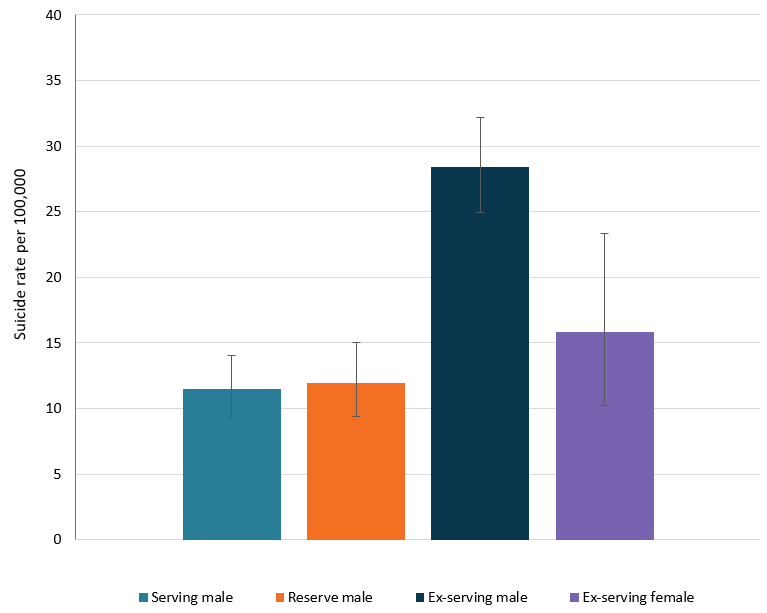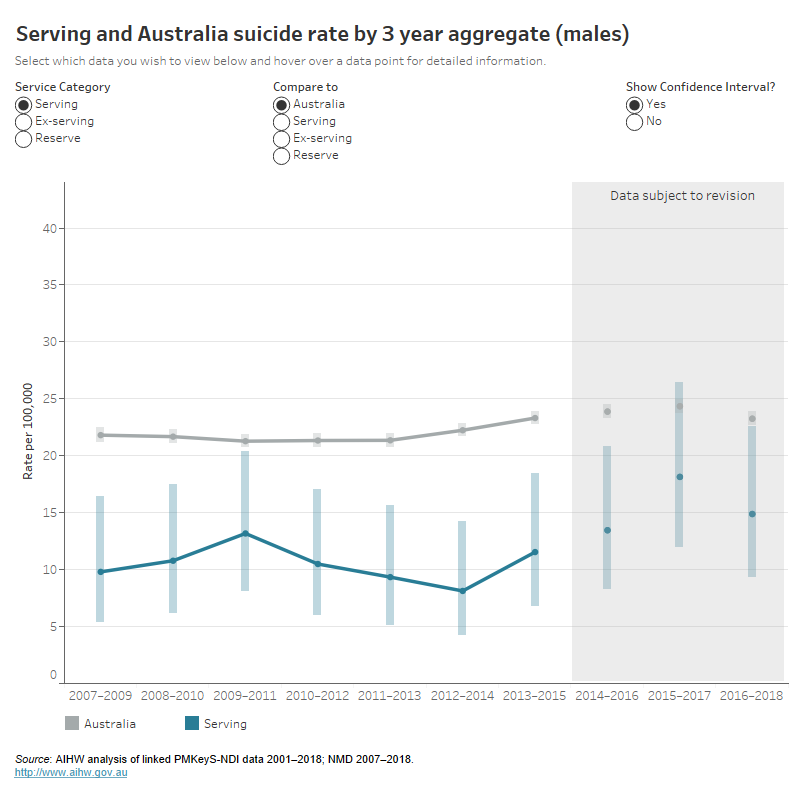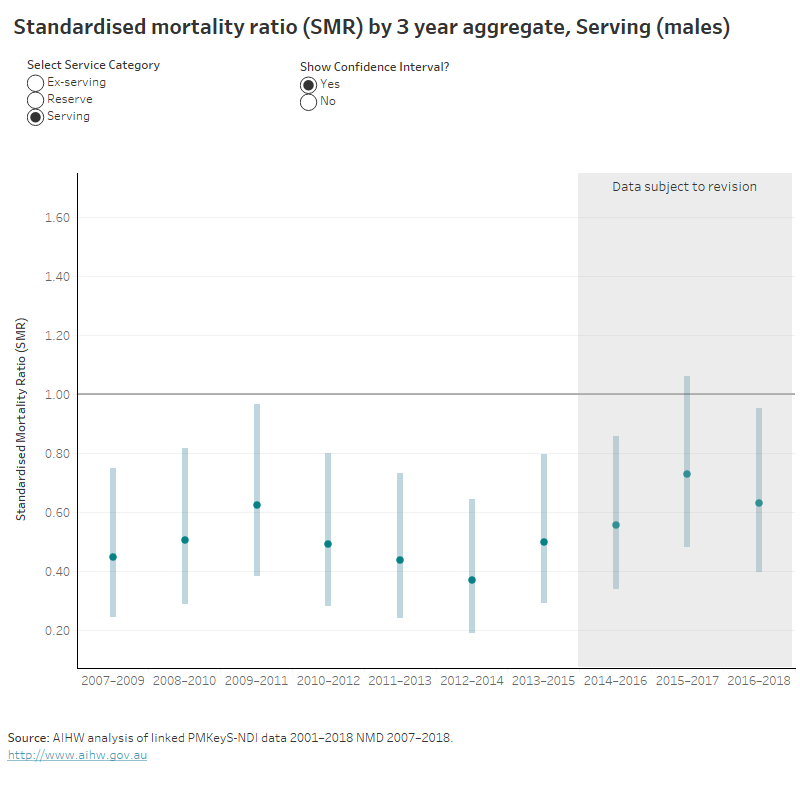Suicides by service status group
Suicide rates have been calculated for the period 2002 to 2018 for each service group. These rates can be validly compared with each other and can be compared with rates for the Australian population. Due to the small number of deaths by suicide among females across the ADF service status groups it was only possible to present the suicide rate for ex-serving females. The suicide rates for 2002-2018 are shown in Figure 1.
The suicide rate for ex-serving males between 2002 and 2018 was 28 per 100,000, which was higher than the rates for serving (11 per 100,000) and reserve males (12 per 100,000). The rate for ex-serving males was also higher than the rate for ex-serving females, which was 16 per 100,000 over the same period.
The suicide rates for serving and reserve males were both lower than Australian males in the same age ranges over the period 2002 to 2018. The rates for ex-serving males and ex-serving females were both higher than in the Australian population over the same period.
Figure 1: Suicide rates for 2002-2018, ADF service groups, males and females

Source: AIHW analysis of linked PMKeyS—NDI data 2002–2018.
Age-adjusted rates by service status group
SMRs were calculated for the period 2002-2018 to control for differences in age distributions between the ADF and Australian populations.
The age-adjusted rate of suicide, when compared to the Australian population was:
- 50% lower for serving males, SMR = 0.50 (95% CI = 0.40-0.61)
- 49% lower for males in the reserves, SMR = 0.51 (95% CI = 0.40-0.64)
- 21% higher for ex-serving males, SMR = 1.21 (95% CI = 1.06-1.38)
- 127% (or 2.27 times) higher for ex-serving females, SMR = 2.27 (95% CI = 1.47-3.35).
These differences were all found to be statistically significant.
Unlike suicide rates, these SMRs cannot be used to compare suicide rates between service groups or across time. This is due to the fact that each SMR a measure that provides a comparison that is specific to the two populations involved.
Suicides by service group over time
Between 2001 and to 2018 there were 465 certified deaths by suicide among males and females with at least 1 day of Australian Defence Force (ADF) service since 1 January 2001. Of these, 267 (57%) occurred among ex-serving personnel (Table 1).
The number of suicides in each service group is presented in Table 1, by single year. It should be noted that the ex-serving population increased each year throughout the study period (2001-2018) as more personnel were discharged from the ADF (see Supplementary table S6.1). Changes in numbers of suicides over time need to be interpreted in the context of these changes.
|
Year |
Serving and Reserve(a) |
Ex-serving(a) |
Total in all ADF service groups(a) |
|---|---|---|---|
|
2001 |
n.p. |
n.p. |
19 |
|
2002 |
n.p. |
n.p. |
15 |
|
2003 |
8 |
10 |
18 |
|
2004 |
n.p. |
n.p. |
15 |
|
2005 |
n.p. |
n.p. |
10 |
|
2006(b) |
7 |
6 |
13 |
|
2007(c) |
11 |
9 |
20 |
|
2008 |
9 |
11 |
20 |
|
2009 |
13 |
13 |
26 |
|
2010 |
13 |
14 |
27 |
|
2011 |
11 |
13 |
24 |
|
2012 |
8 |
18 |
26 |
|
2013 |
12 |
22 |
34 |
|
2014 |
14 |
20 |
34 |
|
2015 |
9 |
32 |
41 |
|
2016 |
15 |
27 |
42 |
|
2017 |
15 |
33 |
48 |
|
2018 |
5 |
28 |
33 |
|
Total |
198 |
267 |
465 |
n.p. Not published because of small numbers or confidentiality.
(a) Consists of deaths by suicide in males and females for serving, reserve and ex-serving ADF personnel.
(b) From 2006 onwards, the ABS implemented a revisions process for coroner-certified deaths (such as suicides). This improved data quality by enabling additional deaths by suicide to be identified beyond initial processing (ABS 2018). For detailed information see Technical Notes.
(c) New ABS coding guidelines were applied for deaths registered from 1 January 2007. The new guidelines improve data quality by enabling deaths to be coded as suicide by ABS mortality coders if evidence indicates the death was from intentional self-harm (ABS 2018). For detailed information see Technical Notes.
Source: AIHW analysis of linked PMKeyS-NDI data 2001–2018.
Suicide rates by service group over time
Rates over time are presented using data summed over 3-year periods, to avoid misinterpretation of trends due to variations in small numbers. For the rolling 3-year periods from 2007 to 2018, the rate of suicide among:
- serving males was between 8 and 18 per 100,000 population
- males in the reserves was between 10 and 15 per 100,000 population
- ex-serving males was between 25 and 33 per 100,000 population.
Significance testing using confidence intervals (CIs) has been used to examine the differences between groups. See Technical notes and Data tables for more detail.
The suicide rate in serving males in the most recent 3-year period (2016-2018) was 15 per 100,000, which was significantly lower than in Australian males. The suicide rate among serving males was consistently lower than the rate in Australian males, and this difference was found to be significant in every 3-year period analysed except for 2015–2017.
The suicide rate in reserve males in the most recent 3-year period (2016-2018) was 13 per 100,000, which was significantly lower than in Australian males. The suicide rate in reserve males was consistently lower than the rate in Australian males, and this difference was found to be significant for the most recent 3-year periods from 2013–2015 to 2016–2018.
The suicide rate in ex-serving males in the most recent 3-year period (2016-2018) was 29 per 100,000, which was higher, though not significantly different to the rate in Australian males. The suicide rate in this group was consistently higher than the rate in Australian males, and this difference was significant in the 3-year periods between 2013–2015 and 2015–2017.
The interactive graph below presents the suicide rates for males in each of the three ADF service status groups and the rates for the comparative population of Australian males, for all 3-year periods from 2007-2009 to 2016-2018.
Data visualisation indicating Serving and Australia suicide rate by 3 year aggregate (males)

Data underlying this graph are available in Supplementary tables S1.2 to S1.4. See Data for a link to the tables.
Please note, data are subject to change: see Technical notes for further detail.
Age-adjusted rates by service status over time - males
In the most recent 3-year period (2016-2018) the age-adjusted rate of suicide in serving males was 37% lower than in Australian males, and this difference was statistically significant. For the 3-year periods between 2007 and 2018 the age-adjusted suicide rate was between 63% (SMR = 0.37 in 2012–2014) and 27% (SMR = 0.73 in 2015–2017) lower than the Australian population. This difference was statistically significant in every 3-year period except 2015–2017.
In the most recent 3-year period (2016-2018) the age-adjusted rate of suicide in reserve males was 47% lower than in Australian males, and this difference was statistically significant. The age-adjusted suicide rate was between 57% (SMR = 0.43 in 2015–2017) and 32% (SMR = 0.68 in 2007–2009) lower than in the Australian population for the 3-year periods between 2007 and 2018, and has been statistically significant in every 3-year period since 2009–2011.
In the most recent 3-year period (2016-2018) the age-adjusted rate of suicide in ex-serving males was 19% higher than in Australian males, though this difference was not statistically significant. For the 3-year periods between 2007 and 2018 the difference varied between 14% (SMR = 1.14) in 2009–2011 and 36% (SMR = 1.36) in 2013–2015. The difference was found to be statistically significant in 2013–2015 and 2015–2017. (see Data tables for more detail).
The SMRs for males in each ADF service status group between 2007–2009 and 2016–2018 are presented in the interactive graph below. For notes on interpreting SMRs, see Technical notes. Select an ADF service group from the menu to display its SMR.

Data underlying this graph are available in Supplementary tables S2.2 to S2.4. See Data for a link to the tables.
Please note, data are subject to change: see Technical notes for further detail.
If you need help or support, please contact:
Open Arms - Veterans and Families Counselling 1800 011 046
Open Arms Suicide Intervention page
ADF All-hours Support Line 1800 628 036
Lifeline 13 11 14
Suicide Call Back Service 1300 659 467
Beyondblue Support Service 1300 22 4636
For information on support provided by DVA see:


